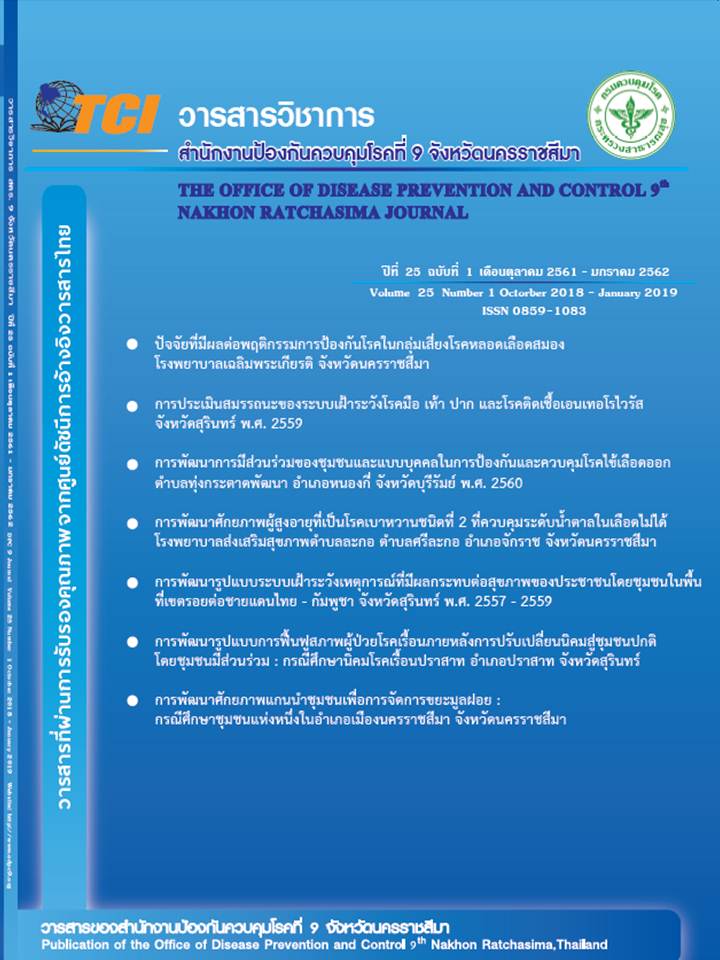Capacity Building of Community Leaders for Waste Management: A Case Study in a Community in Muang District, Nakhon Ratchasima Province
Keywords:
Capacity Building of Community Leaders Guidelines for Waste ManagementAbstract
The purposes of this participatory action research were to develop the potential of community
leaders and to study the results of potentiality development for community leaders in Community waste
management guideline establishment of Phonsung Village, Meunwai Sub-District, Muang
NakhonRatchasima District, NakhonRatchasima Province. The action research concepts were Demming
Cycle (PDCA) and applying self-ef cacy theory of Bandura has self-ef cacy and outcome expectancy.
The research participants were 30 community leaders of Ban Phonsung Moo 4, Muenwai Sub-District,
Muang District, Nakhon Ratchasima Province. Methods used to collect data included a community context
information study, questionnaire, focus group discussion, meeting record, participatory observation
and recording of daily eld note by a researcher. For the analysis of data were frequent, percentage,
mean, standard deviation, maximum, minimum and paired t-test. For the analysis of data, the community
leaders were developing solid waste management in community and organic waste could be useful.
The community leaders of Ban Phon Sung were MuenWai Subdistrict Administrative Organization
to support a budget as follows; 1) to provide organic fertilizer equipment organic waste for support
solid waste management in community and 2) to purchase chicken dispense to solid waste management
community model. The community leaders of Ban Phon Sungwere speci ed guideline for solid waste
management as follows; solid waste management in community, waste of food by supporting chickens
clean out organic waste in community and setting 20 communities model. After that, the community
were extended the results to transform a waste to compost by earthworm stock farming in community
for eating food scraps that remnant from the community, a handmade bag measure of RakPhan
Din Thin Phon Sung market to support handmade bag by special discounting for people who use
handmade bag not a plastic bag, enzyme lonic plasma from organic waste of without a garbage bin
street project, hazardous waste community management, and clean public street in the community every
the second week of the month.
References
บริหารส่วนตำบลหมื่นไวย. นครราชสีมา,2560.
2. กรมควบคุมมลพิษ. ปัญหาสิ่งแวดล้อมจากขยะมูลฝอย [ออนไลน์].2557 [เข้าถึงเมื่อ 2559/12/20]
เข้าถึงได้จาก http://www.pcd.go.th/info_serv/waste_rubbish.htm#top.
3. ปราณี ช่วยชัย. PDCA วงจรคุณภาพ[ออนไลน์]. 2559 [เข้าถึงเมื่อ 2559/10/23] เข้าถึงได้จาก http :
www.gotoknow.Org/posts/447820.
4. อัจฉรา อัศวรุจิกุลชัย. การบริหารจัดการขยะและเทคโนโลยีที่เหมาะสมโดยการมีส่วนร่วมของชุมชน ;กรณี
ศึกษาอบต.ไร่ส้มจ.เพชรบุรี. การบริหารจัดการขยะและเทคโนโลยีที่เหมาะสมโดยการมีส่วนร่วม
ของชุมชน; 2553.
5. ธงชัยทองทวี. ปัญหาสิ่งแวดล้อมจากขยะมูลฝอย. พิมพ์ครั้งที่ 3. กรุงเทพฯ :โรงพิมพ์วิฑูรย์การปก; 2558.

Downloads
Published
How to Cite
Issue
Section
License
บทความที่ลงพิมพ์ในวารสารวิชาการสำนักงานป้องกันควบคุมโรคที่ 9 จังหวัดนครราชสีมา ถือว่าเป็น
ลิขสิทธิ์ สำนักงานป้องกันควบคุมโรคที่ 9 จังหวัดนครราชสีมา



